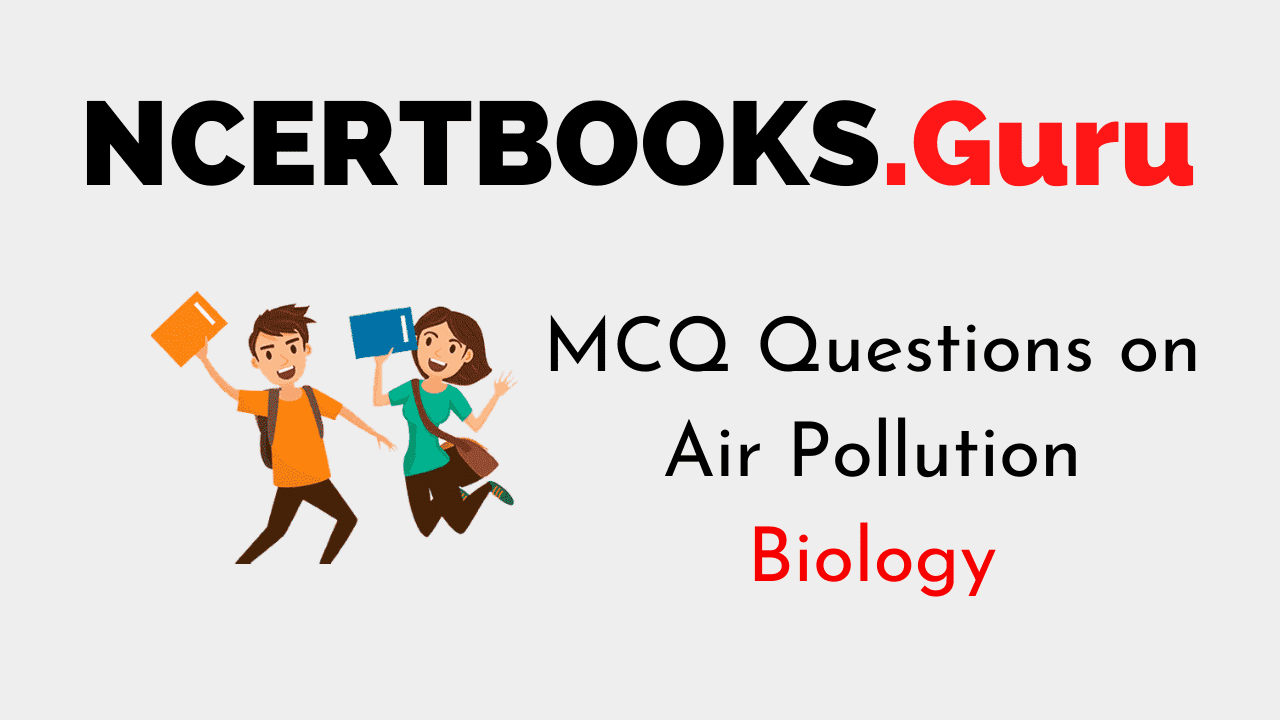Biology is the study of life. Below, You will find a list of Biology MCQ Questions as per the latest prescribed syllabus. Ace up your preparation with the Objective Questions available on Air Pollution and enhance your subject knowledge. Understand the concept clearly by consistently practicing the Multiple Choice Questions and score well in your exams.
MCQ Questions on Air Pollution
1. Who was the first scientist to coin the term SMOG and to describe the layers of SMOG?
(a) Nikola Tesla
(b) Stephen Hawking
(c) Dr Henry Antoine
(d) Nicolaus Copernicus
Answer
Answer: (c) Dr Henry Antoine.
2. Which of the following pollutants are responsible for the cause of SMOG?
(a) From incinerators
(b) Emissions from vehicles
(c) Both incinerators and emissions from vehicles
(d) None of the above
Answer
Answer: (c) Both incinerators and emissions from vehicles.
3. Which of the following is called the secondary air pollutant?
(a) PANs
(b) Ozone
(c) Carbon monoxide
(d) Nitrogen Dioxide
Answer
Answer: (b) Ozone.
4. Which of the following particles is called the particulate pollutants?
(a) Ozone
(b) Radon
(c) Fly Ash
(d) Ethylene
Answer
Answer: (c) Fly Ash.
5. Which of the following agents is responsible for turning the Taj Mahal yellow?
(a) Sulphur
(b) Chlorine
(c) Sulphur dioxide
(d) Nitrogen dioxide
Answer
Answer: (c) Sulphur dioxide
6. Which of the following statements is true about SMOG?
(a) SMOG is derived from the fog
(b) SMOG is derived from smoke
(c) SMOG is derived from water vapour
(d) SMOG is derived from both fog and smoke
Answer
Answer: (d) SMOG is derived from both fog and smoke.
7. What type of precautions should be taken to survive when the ozone level is high?
(a) Drive less
(b) Stay hydrated
(c) Both A and B
(d) Go for a long walk
Answer
Answer: (c) Both A and B.
8. Which of the following statements is true about the Air Quality Index?
(a) It indicates the colour of the air.
(b) It predicts ozone levels in your area.
(c) It determines the intensity of sound and sound pollution.
(d) It estimates air pollution mainly sulphur content in the air.
Answer
Answer: (b) It predicts ozone levels in your area.
9. The major photochemical smog is________.
(a) Hydrogen peroxide
(b) Chlorofluorocarbon
(c) Peroxyacetyl nitrate
(d) All of the above
Answer
Answer: (b) Chlorofluorocarbon.
10. Which of the following diseases are caused by smog?
(a) Rickets
(b) Bronchitis
(c) Breathing Problems
(d) All of the above
Answer
Answer: (d) All of the above.
11. DDT and Aluminium cans are examples of ________.
(a) Primary Pollutants
(b) Secondary pollutants
(c) Biodegradable Pollutants
(d) Non Biodegradable Pollutants
Answer
Answer: (d) Non Biodegradable Pollutants.
12. How many different types of primary pollutants together contribute about 90 per cent of the global air pollution?
(a) Three
(b) Five
(c) Seven
(d) None of the above
Answer
Answer: (b) Five.
13. Which of the following agents is mainly responsible for the secondary pollutants?
(a) Smog and Ozone
(b) Sulphur trioxide
(c) Nitrogen dioxide
(d) All of the above
Answer
Answer: (d) All of the above.
14. Smoke, fumes, ash, dust, nitric oxide and sulphur dioxide are the main sources of ________.
(a) Primary Pollutants
(b) Secondary pollutants
(c) Bio-Degradable Pollutants
(d) None of the above
Sol:
Answer
Answer: (a) Primary Pollutants.
15. Which of the following industries plays a major role in polluting air and increasing air pollution?
(a) Brick manufacturing industries
(b) Manufacture of gases industries
(c) Electrical appliances and electrical goods industries
(d) All of the above
Sol:
Answer
Answer: (d) All of the above.
16. Which of the following gas is more in percentage in the air?
(a) Oxygen gas
(b) Nitrogen gas
(c) Water vapour
(d) Carbon dioxide gas
Answer
Answer: (b) Nitrogen gas
17. Increased levels of air pollution results in _______.
(a) Soil erosion
(b) Global warming
(c) Respiratory problems
(d) All of the above
Answer
Answer: (c) Respiratory problems.
18. The Taj Mahal, Lotus Temple, Golden Temple, India Gate and other famous heritage monuments are being affected by _______.
(a) Air pollution
(b) Water pollution
(c) Noise pollution
(d) All of the above
Answer
Answer: (a) Air pollution.
19. What is the total percentage of nitrogen gas in the air?
(a) 12 per cent
(b) 21 per cent
(c) 78 per cent
(d) 87 per cent
Answer
Answer: (c) 78 per cent.
20. Which of the following gases are called Greenhouse gases?
(a) Methane
(b) Nitrogen
(c) Carbon dioxide
(d) Both a and c
Answer
Answer: (d) Both a and c.
